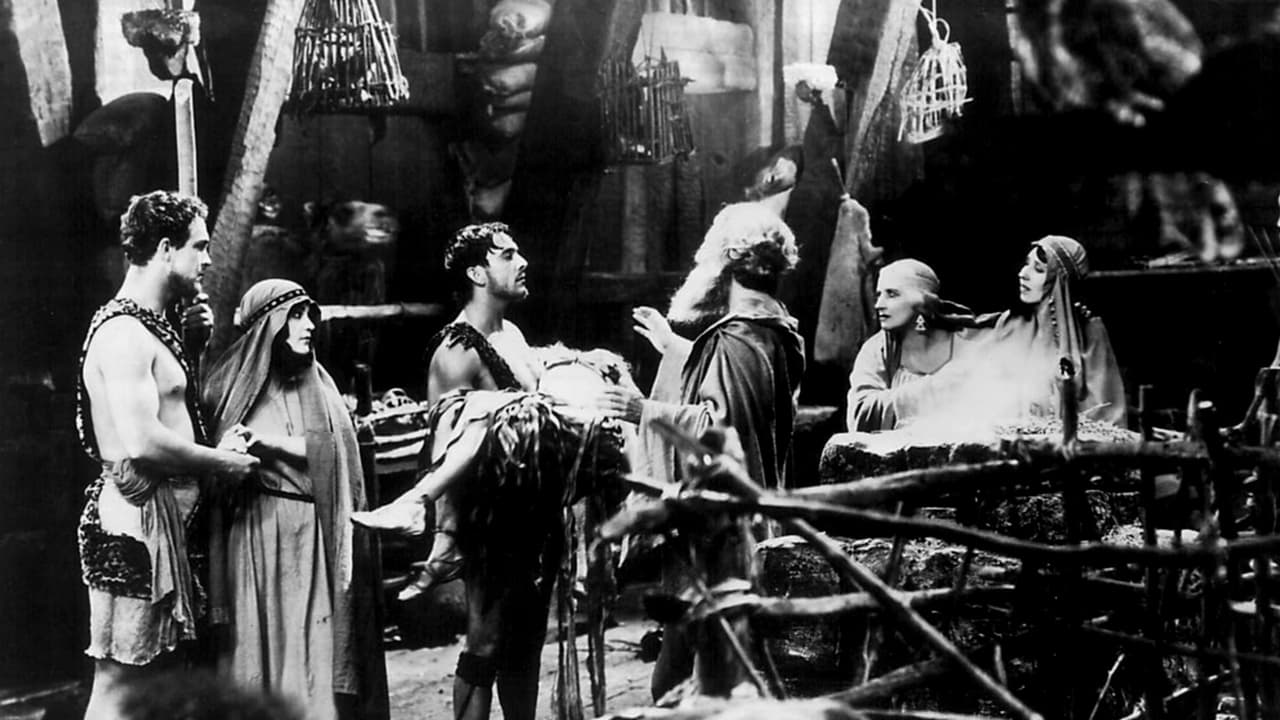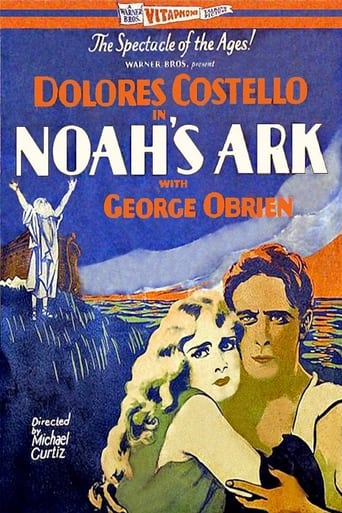

Noah's Ark was the attempt of young hard driving head of production at Warner Brothers Darryl F. Zanuck to produce a biblical spectacle that would out DeMille, DeMille. Like DeMille he took a Victorian era modern story and juxtaposed it with the biblical story of Noah's Ark. And like DeMille leavened his story with a little sex.The leads are George O'Brien and Dolores Costello who play an American national and a German girl who make it to France as war is declared. They fall in love and are married, but her nationality is kept a secret lest she be detained and maybe executed as a spy. When the Yanks come Over There, O'Brien joins up, but Costello gets herself in a jackpot I won't go into except to say that it involves the lecherous Noah Beery. As they await their fate, they are comforted by a minister played by Paul McAllister who seems to pop up in the story in some odd places.At that point McAllister tells them the story of Noah's Ark and the characters in the modern story become characters in the Bible. O'Brien becomes Japheth one of Noah's sons and Costello becomes Miriam, a hand maiden in the house of Noah and O'Brien's girlfriend. Noah Beery becomes the evil Mesopotamian king who demands a virginal sacrifice and guess who he has in mind. And of course McAllister is Noah.The story gets quite a bit of embellishment spiritually as elements from different Bible stories get tossed into the plot. O'Brien like Samson is blinded and condemned to work a grist mill and Noah's sign from God to build the Ark is the burning bush. In addition God is called Jehovah and as we know God had no name until it was revealed to Moses many generations later. C.B. DeMille would have scolded Zanuck for being that bad on scholarship. But he would have applauded Zanuck for the use of scantily clad maidens to show Mesopotamia's decadence.Which the modern minister McAllister and the titled narrative compare to modern times in the tradition of DeMille.Myrna Loy has a role in both the modern and biblical story. If you look you might spot both John Wayne and Andy Devine as extras drowning in God's Flood. O'Brien and Costello make an earnest pair of young lovers who face the future with the hope that no more wars will happen after the Great War as World War One was then called. It should be remembered that the United States and France led many nations to sign the Kellogg-Briand pact around the same time, outlawing war. Just about every nation that signed it did go to war at some point thereafter, except maybe Switzerland. That would have resonated with 1928 audiences as well as the added sequences of dialog which Warner Brothers as the studio which introduced sound would be expected to include.Noah's Ark is a rather dated film, but the special effects were state of the art for its time. It's a curiosity for today's viewers.
... View More"Noah's Ark" was one of Warner Brothers most ambitious and spectacular movies of the late 20s. It originally ran 2 hours and 15 minutes, but when I saw it back in the 60s, it was just over 70 minutes. I can't remember much about it other than being bowled over by the sheer grandeur of it. It was a part talkie, but when Robert Youngson re-edited it for re release in 1957, it was the talking sequences that were eliminated. So the 1950s "Noah"s Ark" emerged as a silent movie with a voice narration filling in the gaps. It was designed along the lines of "Manslaughter"(1923) and "The Ten Commandments" (1923) - as a split story drawing parallels between sin and salvation in the Biblical days to youthful folly in the 'teens. So the famous story of Noah's ark is sandwiched between a World War 1 romance between a German showgirl, Mary (Dolores Costello) and an American soldier, Travis (George O'Brien). Costello and O'Brien also play the parts of the two lovers, Miriam and Japhet, in the Biblical story.In my opinion the Biblical sequence was the most spectacular - the building of the Ark, the herding of the animals, the Tower of Babel and the massive destruction and flooding of the city, including the drowning of the jeering mob. Japhet has been blinded and is forced into a life of slavery on a treadmill - the flood sets him free to be guided by God to rescue Miriam, who was to be sacrificed on the altar to a pagan God - very stirring stuff.Like a lot of silent films with added talking sequences, dialogue trivialized the characters and situations. This occurred in the modern story where a beautiful romance was made banal by long stretches of talk - about patriotism, how wonderful it is to be an American etc. Mary, who is German and at one point is reading a German newspaper on a train, suddenly starts to talk - Travis says to her "You will never be taken for a German spy, you talk just like an American"!! In another scene, a behind the scenes conversation between Myrna Loy and Mary. Loy kindly asks something like "Do you want to talk things over", to which Mary huffily responds "There are some things you'll never understand". Apart from Myrna Loy, who sounded completely at home with dialogue, Noah Beery (who played the villain in both sequences) was the one main star who really acted with his dialogue - he definitely had the type of voice you imagined his character to have. Beautiful Dolores Costello was Warner's top female star (it's top male star was Rin Tin Tin). Before "The Jazz Singer' saved it, Warners was not the powerful studio that it became in the 30s. Costello seemed completely at home in these extravaganzas, in which the only acting required was to look helpless and lovingly into the hero's eyes.The director, Michael Curtiz, was bought to the U.S. in 1926 and had a dictatorial reputation. Chief cameraman Hal Mohr left the film prior to completion because he felt that the handling of the flood scenes and the destruction of the massive sets were a danger to life and wanted safety precautions set in place. Curtiz said extras "would have to take their chances" and as a result several extras drowned.Highly Recommended.
... View MoreNo matter how good this silent movie is, it could never make up for the horribly tragic deaths of several extras due to an indifferent director and studio. When I saw the incredibly spectacular flood scenes, I couldn't help but think about this...as three died to make these scenes.The film is not exactly a film about the flood. Like DeMille's first "Ten Commandments", the Biblical tale is only a small portion of the film--and much of the rest of the film is a heavy-handed contemporary story that only tangentially relates to the Bible. The bulk of the story is about WWI and the film compares this to the flood(!)--about how man's inhumanity that lead to the flood is the same as what lead to the war. And, like the promise of no more earth-covering floods, the film makers were bold enough to promise that with the end of WWI that there would be no wars!! They go so far as to say that the death of over 10,000,000 in the war was NOT in vain! Wishful thinking...especially in light of WWII and countless other wars since! On top of this, the WWI sequence is filled with one amazing one in a million occurrence after another--such as George O'Brien meeting his bestest buddy on the battlefield AND accidentally killing him only minutes later AND having the friend (Guinn Williams) die in his arms! The coincidences were too many to believe and are the result of bad writing--a problem through much of the film.The film goes back and forth several times from the time of Noah to the present. It also throws in several Bible stories that occurred AFTER Noah--and I assume this is because the writers didn't do their homework. There are also one crazy spectacular scene after another--great to look at but poorly written as well, as much of it was just confusing hogwash.A few things to look for (other than amazing special effects for 1928) are the idea of the same characters in WWI playing the sons of Noah and one of their wives. The most prominent of these women is played by Delores Costello--a huge silent star who became one of several wives for John Barrymore (and grandmother of Drew). Also, the scene where O'Brien looks up to Heaven as the rain falls is used on Turner Classic Movies' intro for Silent Sundays.For the most part, the special effects are THE movie. The story itself is confusing, preachy and nonsensical at times. But, in a bizarre way it's all still very entertaining...but hardly a film for the general public. Christians may well object to the fast and loose way the film mixes up the Biblical account as well as creates a lot of back story for Noah's children--from where it got this, I have no idea. Atheists, on the other hand, probably won't like the film because of the whole notion of a world-wide flood and God. So, as a result, much of the potential audience for this film is negated in the process! Overall, confusing, weird yet pretty exciting at times.
... View MoreNOAH'S ARK is the first epic "talkie," though most of it is silent. I got to see a restored print by the University of California, Los Angeles (UCLA), and really enjoyed it. Michael Curtiz directed. (Curtiz later directed CASABLANCA and some of the Elvis Presley films.) George O'Brien stars, with Myrna Loy, Noah Beery and John Wayne.
... View More